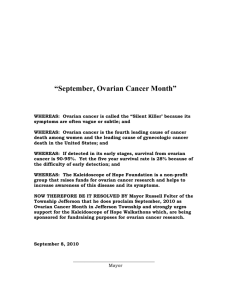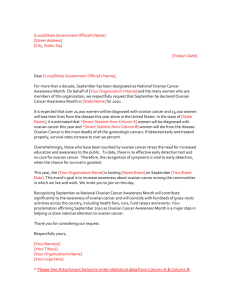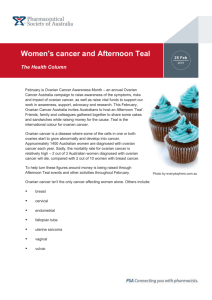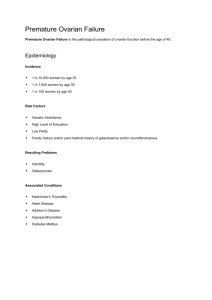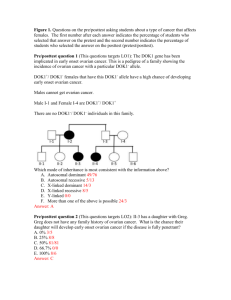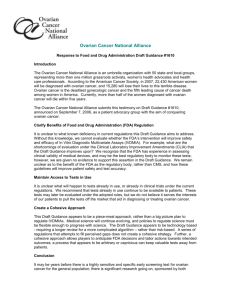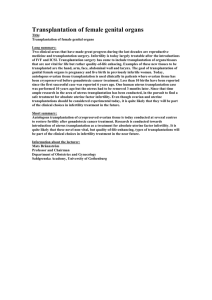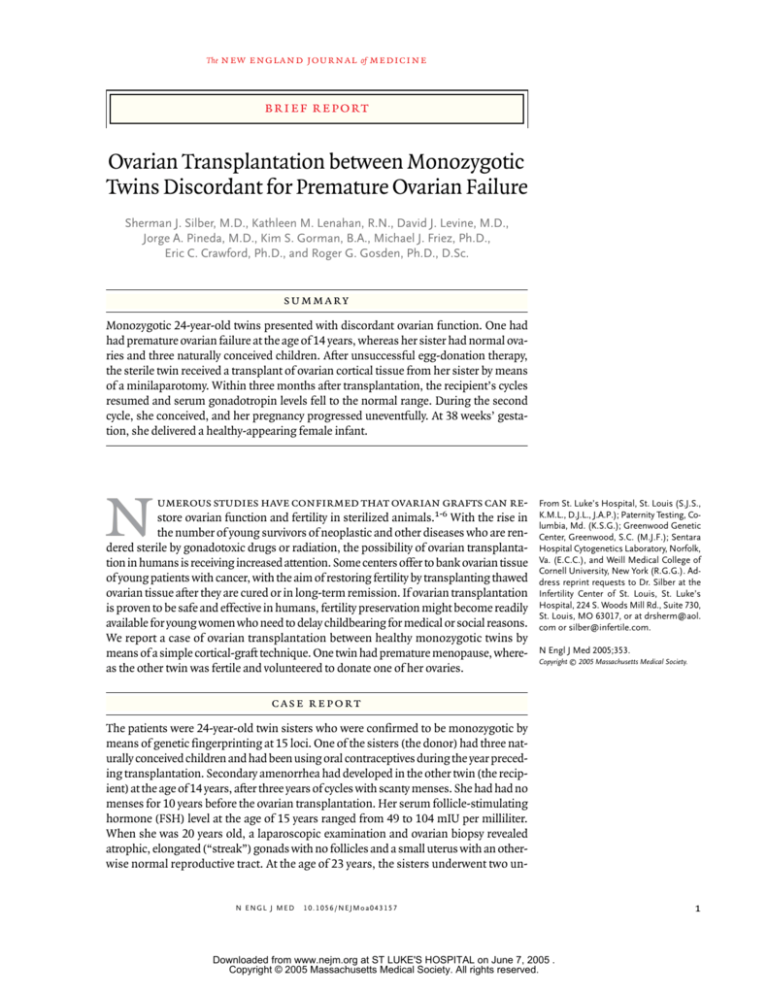
The
new england journal
of
medicine
brief report
Ovarian Transplantation between Monozygotic
Twins Discordant for Premature Ovarian Failure
Sherman J. Silber, M.D., Kathleen M. Lenahan, R.N., David J. Levine, M.D.,
Jorge A. Pineda, M.D., Kim S. Gorman, B.A., Michael J. Friez, Ph.D.,
Eric C. Crawford, Ph.D., and Roger G. Gosden, Ph.D., D.Sc.
summary
Monozygotic 24-year-old twins presented with discordant ovarian function. One had
had premature ovarian failure at the age of 14 years, whereas her sister had normal ovaries and three naturally conceived children. After unsuccessful egg-donation therapy,
the sterile twin received a transplant of ovarian cortical tissue from her sister by means
of a minilaparotomy. Within three months after transplantation, the recipient’s cycles
resumed and serum gonadotropin levels fell to the normal range. During the second
cycle, she conceived, and her pregnancy progressed uneventfully. At 38 weeks’ gestation, she delivered a healthy-appearing female infant.
n
umerous studies have confirmed that ovarian grafts can restore ovarian function and fertility in sterilized animals.1-6 With the rise in
the number of young survivors of neoplastic and other diseases who are rendered sterile by gonadotoxic drugs or radiation, the possibility of ovarian transplantation in humans is receiving increased attention. Some centers offer to bank ovarian tissue
of young patients with cancer, with the aim of restoring fertility by transplanting thawed
ovarian tissue after they are cured or in long-term remission. If ovarian transplantation
is proven to be safe and effective in humans, fertility preservation might become readily
available for young women who need to delay childbearing for medical or social reasons.
We report a case of ovarian transplantation between healthy monozygotic twins by
means of a simple cortical-graft technique. One twin had premature menopause, whereas the other twin was fertile and volunteered to donate one of her ovaries.
From St. Luke’s Hospital, St. Louis (S.J.S.,
K.M.L., D.J.L., J.A.P.); Paternity Testing, Columbia, Md. (K.S.G.); Greenwood Genetic
Center, Greenwood, S.C. (M.J.F.); Sentara
Hospital Cytogenetics Laboratory, Norfolk,
Va. (E.C.C.), and Weill Medical College of
Cornell University, New York (R.G.G.). Address reprint requests to Dr. Silber at the
Infertility Center of St. Louis, St. Luke’s
Hospital, 224 S. Woods Mill Rd., Suite 730,
St. Louis, MO 63017, or at drsherm@aol.
com or silber@infertile.com.
N Engl J Med 2005;353.
Copyright © 2005 Massachusetts Medical Society.
case report
The patients were 24-year-old twin sisters who were confirmed to be monozygotic by
means of genetic fingerprinting at 15 loci. One of the sisters (the donor) had three naturally conceived children and had been using oral contraceptives during the year preceding transplantation. Secondary amenorrhea had developed in the other twin (the recipient) at the age of 14 years, after three years of cycles with scanty menses. She had had no
menses for 10 years before the ovarian transplantation. Her serum follicle-stimulating
hormone (FSH) level at the age of 15 years ranged from 49 to 104 mIU per milliliter.
When she was 20 years old, a laparoscopic examination and ovarian biopsy revealed
atrophic, elongated (“streak”) gonads with no follicles and a small uterus with an otherwise normal reproductive tract. At the age of 23 years, the sisters underwent two un-
N ENGL J MED
10.1056/NEJMoa043157
Downloaded from www.nejm.org at ST LUKE'S HOSPITAL on June 7, 2005 .
Copyright © 2005 Massachusetts Medical Society. All rights reserved.
1
The
new england journal
successful cycles of in vitro fertilization (IVF) at
another center. The donor sister received controlled
ovarian stimulation with standard doses of hormones for egg donation. A total of 14 oocytes (9 of
which were mature) were recovered from 16 preovulatory follicles, and 7 zygotes were generated by
IVF. Pregnancy was not achieved after the transfer
of two fresh embryos or after the transfer of two cryopreserved embryos in a subsequent cycle of IVF.
The twins declined any further attempts at egg
donation. Informed that an attempt could be made
to transplant ovarian tissue, they requested that this
approach be tried instead to restore fertility to the
menopausal sister. The women were in excellent
general health, and the donor’s ovarian function
was considered to be normal on the basis of her reproductive history, peripheral hormone levels, ovarian ultrasonographic findings, and previous ovarian
stimulation for IVF. Peripheral hormones measured
in the infertile twin one day before the transplantation remained at menopausal levels: 75 mIU of FSH
per milliliter, 32 mIU of luteinizing hormone (LH)
per milliliter, and 4 pg of estradiol per milliliter.
of
medicine
A
B
C
methods
surgery
The surgical procedure was approved by the ethics
review committee of St. Luke’s Hospital, and both
sisters provided written informed consent. They
were screened for human immunodeficiency virus
type 1 and hepatitis B and C viruses, and the recipient stopped taking oral contraceptives as hormonereplacement therapy two weeks before surgery. The
donor underwent laparoscopic removal of her left
ovary under general anesthesia. The excised ovary
was then dissected ex vivo. The ovarian cortical tissue was trimmed to a thickness of 1 to 2 mm by excising medullary tissue and bursting small antral
follicles. This dissection was performed in Leibovitz
(L15) medium on ice in less than one hour (Fig. 1A).
Meanwhile, the recipient underwent a minilaparotomy through a 3.5-cm incision above the pubis.
The cortex of each streak ovary was resected under
magnification of 16¬ to 25¬, exposing the entire
raw surface of the medulla. No follicles were observed. Hemostasis was meticulously controlled in
the medulla with the use of pinpoint microbipolar
forceps and continuous irrigation with heparintreated saline in order to prevent the formation of a
hematoma under the graft, but at the same time care
2
N ENGL J MED
Figure 1. Ovarian Transplantation.
Panel A shows the ex vivo dissection of the donor ovarian cortex. Panel B shows the donor cortex being sutured
to the medulla of the recipient after the empty recipient
cortex has been removed. Panel C shows the transplant
after the completion of the procedure.
was taken to avoid impairing revascularization by
minimizing the amount of cautery. A section of approximately one third of the donor ovarian cortex
was laid over the raw medulla of each ovary in the recipient and sutured onto the medulla with the use of
9-0 nylon interrupted stitches (Fig. 1B, 1C, and 2).
The remaining third of the donor ovarian cortex was
cryopreserved after equilibration in 1.5 M 1,2-propanediol and 0.1 M sucrose and slow cooling in an
10.1056/NEJMoa043157
Downloaded from www.nejm.org at ST LUKE'S HOSPITAL on June 7, 2005 .
Copyright © 2005 Massachusetts Medical Society. All rights reserved.
brief report
automated freezer.7,8 Tissue from the ovaries of
both women were fixed in Bouin’s fluid for histologic examination.
laboratory investigations
Uterus
Spare cortical and medullary tissues were cultured
for cytogenetic analyses according to standard procedures, including G-banding. In addition, enzymatically digested ovarian tissue obtained by direct
harvest was examined by fluorescence in situ hybridization. Both women were also evaluated for skewed
X-chromosome inactivation at the androgen receptor locus9 and for an increase in the number of CGG
repeats in the FMR1 gene (indicative of fragile X syndrome) by means of Southern analysis or the polymerase chain reaction, since these mutations have
been associated with premature ovarian failure.10,11
Serum samples were analyzed for FSH, LH, and estradiol with the use of standard immunoassays.
results
Both patients recovered rapidly and returned to their
home state just one day after surgery. Seventy-one
days after transplantation, a 14-mm follicle had developed in the recipient; the serum estradiol level at
this time was 154 pg per milliliter (Table 1) and the
uterine-lining thickness was 8 mm. At 80 days, she
had her first postoperative menses, although it lasted only a single day. The endocrine profile indicated
that her ovaries then remained quiescent until 48
days later (128 days after transplantation), when a
14-mm follicle was again noted sonographically.
The thickness of the uterine lining was 10 mm, the
estradiol level was 193 pg per milliliter, and the LH
level was 123.4 mIU per milliliter. Her basal body
temperature then rose from 36.4 to 36.9°C and remained elevated for 13 days. At 141 days after transplantation, her serum FSH and LH had decreased to
9.1 and 4.7 mIU per milliliter, respectively. The following day, a heavy menstrual period began, and
her basal body temperature dropped.
On day 3 of the second menstrual cycle (145 days
after transplantation), the recipient’s FSH level was
7.1 mIU per milliliter. On day 26 of the same cycle,
her b human chorionic gonadotropin level was 828
mIU per milliliter. Ultrasonographic examination
five weeks after her second menstrual period (day
176 after transplantation) revealed a normal intrauterine pregnancy with a well-defined secondary
yolk sac; the b human chorionic gonadotropin level was then 30,289 mIU per milliliter. She had con-
N ENGL J MED
Ovarian
medulla
Dissected
donor ovary
ready for
placement
Donor ovary sutured
onto recipient
ovarian medulla
Figure 2. Schematic illustration of Ovarian Transplantation.
ceived naturally. At seven weeks, ultrasonography
verified that she had a normally developing intrauterine pregnancy associated with a fetal heart rate
of 148 beats per minute. The 22-week ultrasonogram was completely normal. She gave birth to a
healthy-appearing girl at 38 weeks’ gestation by vaginal delivery. The infant’s birth weight was 3600 g,
and the Apgar scores were 9 at one minute and 10 at
five minutes.
All specimens (peripheral lymphocytes, ovarian
cortex, and ovarian medulla) from both patients
had a normal 46,XX karyotype, and G-banding did
not reveal any structural chromosomal aberrations.
Moreover, dual-colored fluorescence in situ hybridization of 250 cells from each sample of uncultured
tissue with the use of probes for two genes on the
sex chromosomes (DXZ1 and SRY, Vysis) did not reveal any XX–XY mosaicism. The degree of inactivation of the X chromosome was within normal limits
in both patients (50:50 for the donor and 65:35 for
the recipient), and neither patient had an increase
in the number of CGG repeats in the FMR1 gene that
was in the premutation or mutation range.
Tissue sections from each sister were compared.
10.1056/NEJMoa043157
Downloaded from www.nejm.org at ST LUKE'S HOSPITAL on June 7, 2005 .
Copyright © 2005 Massachusetts Medical Society. All rights reserved.
3
The
new england journal
Table 1. Serum Gonadotropin and Estradiol Levels
before and after Isologous Ovarian Grafting.*
FollicleStimulating
Hormone
Days
Luteinizing
Hormone
mIU/ml
of
medicine
A
Estradiol
pg/ml
Before transplantation
1
74.6
32.1
4
44
90.3
33.7
—
71
45.6
36.9
154
After transplantation
80
50µm
B
84
34.9
—
100
68.5
26.2
54
128
50.2
123.4
193
141
9.1
4.7
196
142
—
50µm
Second menses
145
7.1
—
—
167†
—
—
—
50µm
* Dashes indicate that a measurement was not obtained.
† On day 167 after transplantation (day 26 of the second
menstrual cycle), the b human chorionic gonadotropin
level was 828 mIU per milliliter.
The streak ovaries of the recipient had no detectable
follicles (Fig. 3). There was extensive fibrosis, including fibrotic remnants of old corpora albicantia
presumably dating from the sporadic ovulatory cycles that had last occurred more than a decade earlier. The smaller fragments of tissue from the donor
ovary appeared histopathologically normal and contained follicles of various sizes. Tissue from the
contralateral ovary of the donor was not available
for study, but its size and appearance suggested that
this ovary was also normal.
discussion
We describe a successful pregnancy in a prematurely menopausal monozygotic twin who received an
ovary from her healthy, fertile twin. The pregnancy
was established spontaneously, without ancillary
medical assistance. It is extremely unlikely that the
restoration of ovarian function in this patient after
transplantation was due to residual follicles in the
streak ovary of the recipient; she had a decade-long
history of amenorrhea with elevated gonadotropin
levels on all occasions on which they were measured
4
C
First menses
N ENGL J MED
Figure 3. Histologic Findings in the Streak Ovary of the
Recipient (Panel A) and the Ovary of the Donor (Panels B
and C) (Hematoxylin and Eosin).
Follicles were completely absent in the recipient’s ovary
(Panel A). In contrast, her twin sister’s ovary had four
primordial follicles (Panel B) and a developing follicle
(Panel C) in this section.
and no detectable follicles on pathological examination.
Studies in animals have indicated that only primordial follicles survive transplantation-related ischemia,12 but the rapid onset of cyclicity in our patient suggested that at least one growing follicle had
survived and grown to maturity. However, follicle
recruitment may not have normalized until the second cycle, about three months after transplantation,
when serum levels of gonadotropin and estrogen
returned to levels characteristic of those in young,
fertile women. Endometrial thickness also reached
preovulatory dimensions at this time, and an LH
surge and elevated basal body temperature indicated that ovulation had occurred. The patient conceived naturally during this cycle.
Grafting of ovarian cortex was chosen because it
is minimally invasive and involves substantially less
10.1056/NEJMoa043157
Downloaded from www.nejm.org at ST LUKE'S HOSPITAL on June 7, 2005 .
Copyright © 2005 Massachusetts Medical Society. All rights reserved.
brief report
risk and recovery time than a vascular graft (which
one of us described in a report of testis transplantation between male homozygous twins discordant
for anorchia13). Moreover, cortical grafting (in contrast to vascular anastomosis) affords the opportunity to cryopreserve additional ovarian tissue for a
future transplantation, should it be required. To
date, whole-ovary cryopreservation has been successful only in rats and would be unlikely to be effective with the much larger human ovary.14 Although heterotopic grafts of human (or monkey)
cortical tissue can generate mature oocytes for
IVF,15-17 we did not pursue that strategy in the
present case because the twins had declined further attempts at IVF.
An important technical limitation of cortical
grafting, whether orthotopic or heterotopic, is the
potential for follicle atresia during the period of ischemia, before the tissue becomes revascularized12,18; such an event might compromise longterm ovarian function. Yet experimental studies suggest that long-term ovarian function may not be
compromised by grafting.6 Studies in animals have
indicated that a short interval before conception is
related to adequate follicular reserves and that the
use of grafted ovarian cortex can result in prolonged
resumption of fertility.6 In the current case, the recipient’s low levels of serum FSH on day 3 of the second cycle (after she had received only two thirds of
one ovary from her sister) and the rapid return of
normal ovarian function suggest that normal menstrual cycles and fertility may resume in this patient
after pregnancy. If, however, ovarian function were
not maintained over the long term, the recipient
could receive a second graft of remaining cryopreserved tissue.
The procedure we used is based on a simple
method that was first described in sheep.19-21 In
the first reported clinical cases of ovarian autografting, ovarian function was transitory, perhaps because of a paucity of follicles in the grafted tissue as
a result of prior chemotherapy.22,23 Recently, a viable pregnancy was reported after ovarian-tissue
banking and transplantation in a patient who was
thought to be sterile after treatment for Hodgkin’s
disease.24 However, doubts have been expressed as
to whether ovulation in that conception cycle occurred from the grafted tissue or from tissue left
in situ and in close proximity to the graft.25 It is
impossible to verify the origin of the fertilized egg
in that case retrospectively, but the present report
provides a compelling demonstration that cortical grafts can restore fertility. Furthermore, our technique involved a single, simple procedure rather
than repeated laparoscopic procedures to attach
multiple slices of tissue to the pelvic wall. Cryopreservation is not required for this procedure, but if a
second transplantation is required, frozen–thawed
tissue can be used; experimental evidence suggests
that cryopreservation should have only a minor effect on follicular wastage.7 Routine genetic testing
revealed no obvious cause for the discordance between these monozygotic twin sisters, nor any obvious cause for concern about the health of future
offspring.
Although ovarian transplantation between
monozygotic twins will be rare, the demonstration
that ovarian function can be restored and that natural conception and successful pregnancy can be
achieved after transplantation of ovarian tissue may
have broader implications for preserving fertility
in young women, such as those who require potentially sterilizing treatment for cancer.
We are indebted to Dr. Braden Richmond for his follow-up care in
Alabama, to Julie Heintzelman for manuscript preparation, and to
Debby Grenia for coordination of the studies.
references
1. Nugent D, Meirow D, Brook PF, et al.
Transplantation in reproductive medicine:
previous experience, present knowledge and
future prospects. Hum Reprod Update 1997;
3:267-80.
2. Gosden RG, Aubard Y. Transplantation
of ovarian and testicular tissues (medical intelligence unit). Austin, Tex.: Landes Bioscience, 1996.
3. Sonmezer M, Oktay K. Fertility preservation in female patients. Hum Reprod Update 2004;10:251-66.
4. Parrott DMV. The fertility of mice with
orthotopic ovarian grafts derived from frozen tissue. J Reprod Fertil 1960;1:230-41.
5. Gunasena KT, Villines TM, Critser ES,
Critser JK. Live births after autologous
transplant of cryopreserved mouse ovaries.
Hum Reprod 1997;12:101-6.
6. Candy CJ, Wood MJ, Whittingham DG.
Restoration of a normal reproductive
lifespan after grafting of mouse ovaries.
Hum Reprod 2000;15:1300-4.
7. Newton H, Aubard Y, Rutherford A,
Sharma V, Gosden R. Low temperature storage and grafting of human ovarian tissue.
Hum Reprod 1996;11:1487-91.
8. Gook DA, Edgar DH, Stern C. Effect of
cooling rate and dehydration regimen on
the histological appearance of human ovari-
N ENGL J MED
an cortex following cryopreservation in 1,2propanediol. Hum Reprod 1999;14:2061-8.
9. Allen RC, Zoghbi HY, Moseley AB,
Rosenblatt HM, Belmont JW. Methylation of
HpaII and HhaI sites near the polymorphic
CAG repeat in the human androgen-receptor
gene correlates with X chromosome inactivation. Am J Hum Genet 1992;51:1229-39.
10. Maddalena A, Richards CS, McGinniss
MJ, et al. Technical standards and guidelines for fragile X: the first of a series of disease-specific supplements to the Standards
and Guidelines for Clinical Genetics Laboratories of the American College of Medical
Genetics. Genet Med 2001;3:200-5.
10.1056/NEJMoa043157
Downloaded from www.nejm.org at ST LUKE'S HOSPITAL on June 7, 2005 .
Copyright © 2005 Massachusetts Medical Society. All rights reserved.
5
brief report
11. Sherman SL. Premature ovarian failure
among fragile X premutation carriers: parent-of-origin effect? Am J Hum Genet 2000;
67:11-3.
12. Baird DT, Webb R, Campbell BK, Harkness LM, Gosden RG. Long-term ovarian
function in sheep after ovariectomy and
transplantation of autografts stored at
¡196°C. Endocrinology 1999;140:462-71.
13. Silber SJ. Transplantation of a human
testis for anorchia. Fertil Steril 1978;30:1817.
14. Wang X, Chen H, Yin H, Kim SS, Lin Tan
S, Gosden RG. Fertility after intact ovary
transplantation. Nature 2002;415:385.
15. Oktay K, Economos K, Kan M, Rucinski
J, Veeck L, Rosenwaks Z. Endocrine function and oocyte retrieval after autologous
transplantation of ovarian cortical strips to
the forearm. JAMA 2001;286:1490-3.
16. Oktay K, Buyuk E, Veeck L, et al. Embryo
development after heterotopic transplanta-
6
tion of cryopreserved ovarian tissue. Lancet
2004;363:837-40.
17. Lee DM, Yeoman RR, Battaglia DE, et al.
Live birth after ovarian tissue transplant.
Nature 2004;428:137-8.
18. Kim SS, Yang HW, Kang HG, et al.
Quantitative assessment of ischemic tissue
damage in ovarian cortical tissue with or
without antioxidant (ascorbic acid) treatment. Fertil Steril 2004;82:679-85.
19. Gosden RG, Baird DT, Wade JC, Webb
R. Restoration of fertility to oophorectomized sheep by ovarian autografts stored at
¡196°C. Hum Reprod 1994;9:597-603.
20. Aubard Y, Piver P, Cogni Y, Fermeaux V,
Poulin N, Driancourt MA. Orthotopic and
heterotopic autografts of frozen-thawed
ovarian cortex in sheep. Hum Reprod 1999;
14:2149-54.
21. Salle B, Demirci B, Franck M, Rudigoz
RC, Guerin JF, Lornage J. Normal pregnancies and live births after autograft of frozen-
N ENGL J MED
thawed hemi-ovaries into ewes. Fertil Steril
2002;77:403-8.
22. Oktay K, Karlikaya G. Ovarian function
after transplantation of frozen, banked autologous ovarian tissue. N Engl J Med 2000;
342:1919.
23. Radford JA, Lieberman BA, Brison DR,
et al. Orthotopic reimplantation of cryopreserved ovarian cortical strips after high-dose
chemotherapy for Hodgkin’s lymphoma.
Lancet 2001;357:1172-5.
24. Donnez J, Dolmans MM, Demylle D, et
al. Live birth after orthotopic transplantation of cryopreserved ovarian tissue. Lancet
2004;364:1405-10. [Erratum, Lancet 2004;
364:2020.]
25. Oktay K, Tilly J. Live birth after cryopreserved ovarian tissue autotransplantation.
Lancet 2004;364:2091-3.
Copyright © 2005 Massachusetts Medical Society.
10.1056/NEJMoa043157
Downloaded from www.nejm.org at ST LUKE'S HOSPITAL on June 7, 2005 .
Copyright © 2005 Massachusetts Medical Society. All rights reserved.

